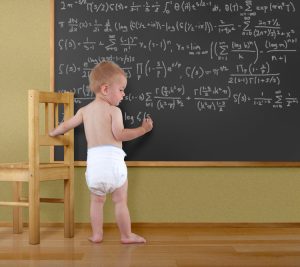
Setting your preschooler on the path to math
Some of you who are reading this may have your back up already, thinking about the fact that finding the area of an Isosceles Triangle hasn’t found any practical application for you since leaving high school. Or, maybe you found equations and multiplication tables stimulating and interesting but parted ways as you graduated and headed on toward the adult world. Either way, don’t let your path away from math blind you to the advantages of getting your preschooler started early on a skill set that’s a proven tool for success.
Teaching the fundamentals of arithmetic to preschoolers lays the foundations for the kind of logical and critical thinking that will benefit ![]()
 them their entire lives. They will also learn the basics of how to analyze and identify patterns, see relationships and acquire the problem solving skills that will assist them as they grow and mature. Of course, that doesn’t mean your preschooler’s bedtime stories should be replaced with a rigorous academic dose of trigonometry and calculus. Introducing your child to simple numbers and other math concepts is the proper way to begin and share in a variety of fun and interesting activities.
them their entire lives. They will also learn the basics of how to analyze and identify patterns, see relationships and acquire the problem solving skills that will assist them as they grow and mature. Of course, that doesn’t mean your preschooler’s bedtime stories should be replaced with a rigorous academic dose of trigonometry and calculus. Introducing your child to simple numbers and other math concepts is the proper way to begin and share in a variety of fun and interesting activities.
Exercise
Why not begin by combining a little exercise into a drill? Taking your toddler out for a morning or afternoon stroll and counting the cracks in the sidewalk gets little legs and brains working at the same time. Shapes are important as well. Putting together a simple rectangle, triangle and square with foam sticks on the bathtub wall will familiarize your toddler with these shapes. You can make a game of identifying each one and then encouraging him to put the color coded sticks back in the same designs.
Teaching your daughter about measurement is easier when you use tablespoons and cups as you cook. She can count how many cups of flour go into the pancake mix and start piecing together the beginnings of an understanding about important concepts like weights and measures.
Everyday chores
Your son can learn about colors, shapes and sizes by helping you with some everyday chores around the house like doing the laundry. Teaching him how to differentiate between objects that are the same and ones that are different is important and asking him to sort the family’s socks by color is a great way to start.
Although math was taught as a standalone subject for years, it is now being incorporated into the entire curriculum so children reading stories, singing songs, or painting pictures might be asked to describe the geometry involved in art or even count some aspect of a story being read to them. It’s all the more reason to get them involved early.
Finally, you need to keep in mind every child develops at a different pace and finding one that works best for you both means being aware of the areas where they show the most interest and balancing in other skills at the same time. For example, if your son or daughter appears to be on the path to math, you should consider reading to them from a book with numbers in it to pique that interest as well.
Read more info like this at All My Children.
Author: Rob Starr